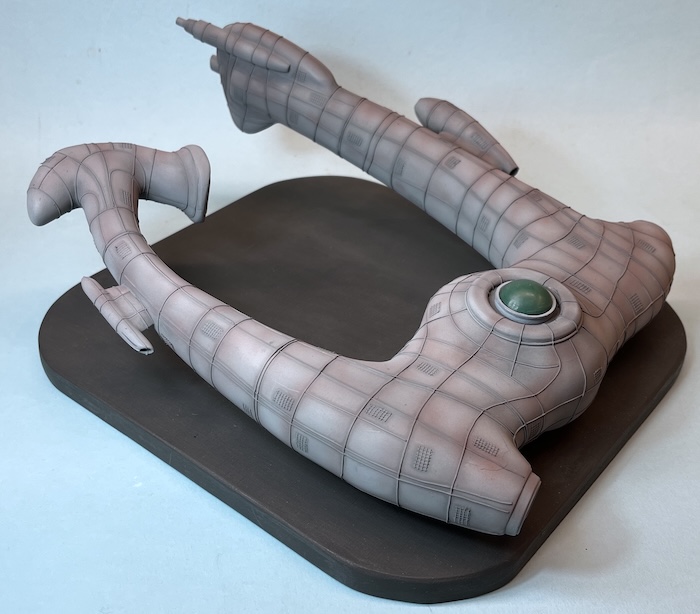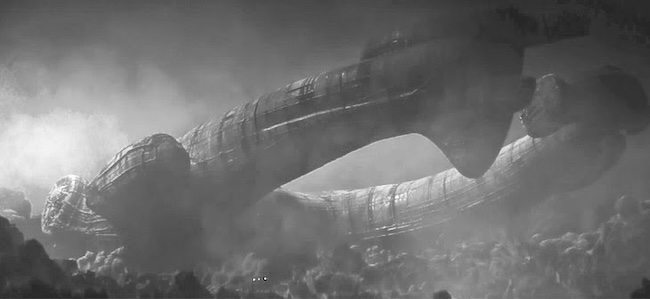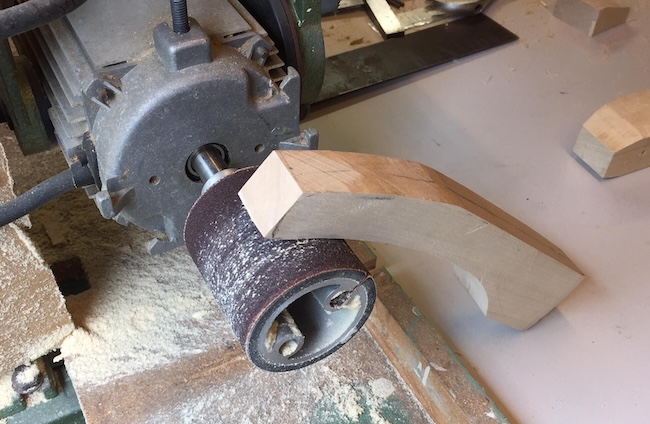Scratch Build
Special Feature Article With Roger Brown

(Photo: The finished derelict ship from the film Alien)

The Alien Derelict Ship was an Engineer Spacecraft which crashed on Acheron, LV-426, one of the three moons of the planet Calpamos.
In 2122, an unknown warning signal broadcast from the Derelict summoned the Federation towing vehicle Nostromo to LV-426.
And what a big mistake that was.
The Derelict is believed to have crashed on Acheron several millennia prior to the arrival of the space tug Nostromo.
The left arm on the Derelict measures 161.6 meters in length and the right arm 174.3 meters. The craft is 116.6 meters wide and 61.0 meters wide between the starboard and port arms.
As for the engines that power the Derelict, not much is known about this aspect, except to say that it possessed an FLT (faster than light) drive.
Also the direction of flight appears to be with the central hub leading and the arms trailing, with the ability to take off and land vertically.
The organic look of the craft gives the impression that they were ‘grown’ as opposed to being manufactured in the traditional way.
The Derelict was designed by the Swiss artist H.R. Giger, as was the Alien creature and the internal set of the Derelict.
H.R. Giger designed and worked on all of the alien aspects of the film, which he designed to appear organic and biomechanical in contrast to the industrial look of the Nostromo and it’s human elements.
The 1979 Film ‘Alien’ featured four principal craft; the commercial space tug-Nostromo, the Refining Platform, the escape shuttle-Narcissus, and the Derelict.
As I remember there are or were available, models of the Nostromo and Narcissus, die-cast or resin models of the Derelict and a larger resin model of the Nostromo and refinery.
However I do enjoy a scratch build so decided to build my own model of the Derelict, as it is one of the most iconic and unusual space craft ever to be seen in on film.
There are many images to be found on the web and they all vary slightly in certain areas from the original drawings made by H.R.Giger.
What I did find though was a free download of a paper model which looked very close to the original design.
Design
The paper model was a little larger than I wanted so I scaled down the plan and side views until the craft in plan view fitted onto a sheet of A4 paper, which worked out to about 1:650 scale.
All the dimensions of the various components were measured from scaled down prints of the paper model.
Now this was a model of which the construction would not involve the cutting and forming of sheets of plasticard of which my previous models largely consist.
This model would be carved out of the solid, with very few straight surfaces or edges, using basswood Basswood is very easy to obtain from model shops or on line and I bought two pieces 2” x 2” x 12” for the arms, a sheet 3” x ¼” x 24” for the laminations of the central hub and a sheet 3” x ½” x 24” for the other detail parts.
I am fortunate to posses a radial arm woodworking saw on which I could make the main cuts to produce the plan and side elevations of the arms and then swap the saw blade out for a 2 ½” sanding drum to shape and smooth everything off square prior to marking centre lines as a guide to shape the elliptical sections of the arms.

There are additionally six detail parts to make; the ‘hammer head’ for the left hand arm, the ‘bow piece’ and two projecting tubes, which fit on the end of the right hand arm, two side pods, and two circular projections on the front of each of the arms at the central hub end.